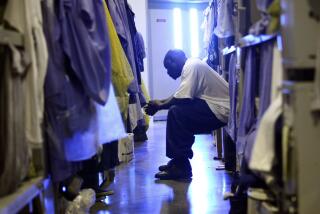Computer errors allow violent California prisoners to be released unsupervised
Reporting from Sacramento -- Computer errors prompted California prison officials to mistakenly release an estimated 450 inmates with “a high risk for violence” as unsupervised parolees in a program meant to ease overcrowding, according to the state’s inspector general.
More than 1,000 additional prisoners presenting a high risk of committing drug crimes, property crimes and other offenses were also let out, officials said.
No attempt was made to return any of the offenders to state lockups or place them on supervised parole, said inspector general spokeswoman Renee Hansen.
All of the prisoners were placed on “non-revocable parole,” whose participants are not required to report to parole officers and can be sent back to prison only if caught committing a crime. The program was started in January 2010 for inmates judged to be at very low risk of reoffending, leaving parole agents free to focus on supervising higher-risk parolees.
The revelations come two days after the U.S. Supreme Court ruled that California’s prisons are dangerously overcrowded and upheld an earlier order that state officials find a way to reduce the 143,335-inmate population by roughly 33,000. The state has two years to comply.
State Sen. Ted Lieu (D-Torrance), a former prosecutor who requested an investigation of the unsupervised-parole program, said the inspector general’s report “confirms my worst fears” about it.
Investigators reviewed case files for 200 of the 10,134 former inmates who were on non-revocable parole in July of last year. They found that 31 were not eligible, and nine of those were determined likely to commit violent crimes. The inspector general and corrections officials refused to identify the inmates who were released erroneously. They also would not specify what their original offenses had been.
Using the 15% error rate they found in their sample, investigators estimated that more than 450 violent inmates had been released during the first seven months of the program, the time period they reviewed. Prison officials have disputed the findings, saying they had corrected some of the computer problems discovered by the inspector general. The error rate is now 8%, the inspector general report says.
Gov. Jerry Brown’s plan to address overcrowding would shift tens of thousands of low-level offenders from prison to county custody. Counties would also supervise most low-risk parolees, like those in the non-revocable program.
But if the state can’t properly identify which inmates qualify for an unsupervised parole program, Lieu said on Wednesday, “how can the public have confidence they can release 33,000 felons safely?”
Under the law that created non-revocable parole, inmates are excluded if they are gang members, have committed sex crimes or violent felonies or have been determined to pose a high risk to reoffend based on an assessment of their records behind bars.
That’s where the problems begin, according to the inspector general. The computer program prison officials used to make that assessment does not access an inmate’s disciplinary history.
The program also relies on a state Department of Justice system that records arrests but is missing conviction information for nearly half of the state’s 16.4 million arrest records, according to the inspector general report.
Lee Seale, a deputy chief of staff for the California prisons, acknowledged that the corrections department’s computer system can’t access an inmate’s disciplinary record. But that information is reviewed manually by a member of his staff before prisoners are released, said spokesman Luis Patino.
Seale agreed that the missing conviction information from the Department of Justice database is a problem. “That presents a serious issue for the entire criminal justice system, every judge, every probation officer, every cop on the street trying to decide whether to arrest someone,” Seale said.
In July, a parolee named Javier Joseph Rueda, who had been classified a low-level offender and placed in the non-revocable program, opened fire on two Los Angeles police officers, hitting one in the arm. The police returned fire, killing Rueda.
Prison spokesman Oscar Hidalgo said Rueda had been properly classified. At the time, Hidalgo pointed out that the attack could have taken place even if Rueda had been checking in periodically with a parole agent.
“Supervised parole is not incarceration,” Hidalgo said.
More to Read
Sign up for Essential California
The most important California stories and recommendations in your inbox every morning.
You may occasionally receive promotional content from the Los Angeles Times.










